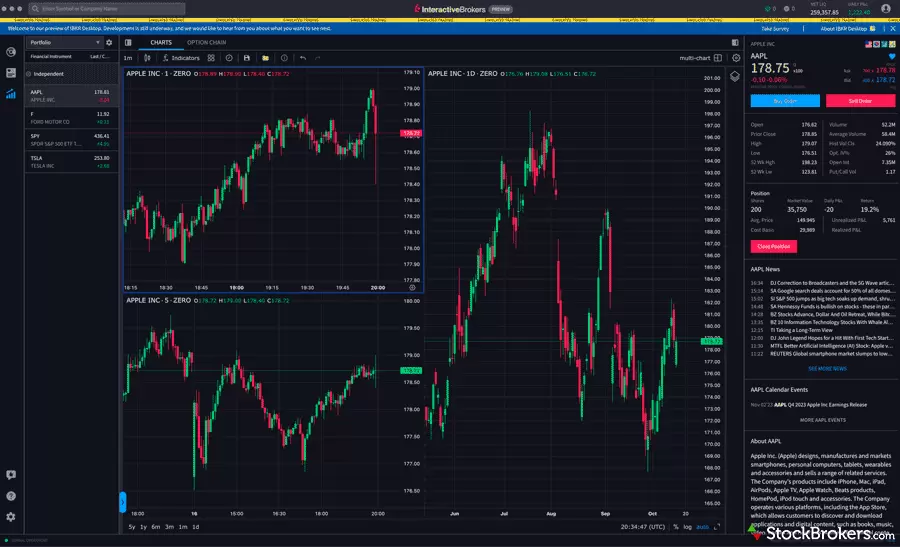Did you know that the average day trader spends more time analyzing charts than a chef spends chopping vegetables? Building a robust futures day trading portfolio is no small feat—it's a blend of strategy, analysis, and risk management. In this article, we delve into what a futures day trading portfolio is and guide you through the essential components for success. We’ll cover how to choose the right futures contracts, effective strategies, required capital, and key risks to manage. Plus, we'll highlight the best tools for analysis, diversification techniques, common pitfalls to avoid, and the tax implications of your trades. With insights from DayTradingBusiness, you'll be equipped to create a portfolio that thrives in dynamic markets.
What is a futures day trading portfolio?
A futures day trading portfolio consists of a collection of futures contracts you actively trade within a single day. To build one, start by selecting a few liquid contracts, like E-mini S&P 500 or crude oil futures. Diversify across different sectors to manage risk. Use technical analysis to identify entry and exit points, and set strict stop-loss orders to protect your capital. Regularly review and adjust your portfolio based on market conditions and your trading performance. Focus on risk management and consistent strategy application to enhance profitability.
How do I start building a futures day trading portfolio?
To start building a futures day trading portfolio, follow these steps:
1. Educate Yourself: Learn the basics of futures trading, including key concepts, market dynamics, and trading strategies.
2. Choose a Market: Select the futures markets that interest you, such as commodities, indices, or currencies.
3. Develop a Trading Plan: Create a clear plan outlining your goals, risk tolerance, and strategies for entering and exiting trades.
4. Select a Brokerage: Choose a reputable brokerage that offers futures trading with competitive commissions and a user-friendly platform.
5. Fund Your Account: Deposit enough capital to meet margin requirements and allow for effective trading.
6. Practice with a Demo Account: Use a demo account to practice your strategies without risking real money.
7. Start Small: Begin trading with a small number of contracts and gradually increase your exposure as you gain experience.
8. Monitor Your Trades: Keep track of your trades and analyze your performance regularly to refine your approach.
9. Manage Risk: Implement risk management techniques, like stop-loss orders, to protect your capital.
10. Stay Informed: Keep up with market news and trends that can impact your trading decisions.
By following these steps, you can effectively build a futures day trading portfolio.
What are the essential components of a futures trading portfolio?
The essential components of a futures trading portfolio include:
1. Diverse Asset Selection: Include a mix of commodities, indices, and currencies to spread risk.
2. Risk Management Strategy: Set stop-loss orders and position sizing to protect capital.
3. Trading Plan: entry and exit strategies based on technical analysis and market trends.
4. Capital Allocation: Decide how much capital to allocate to each trade to maintain balance.
5. Market Research Tools: Utilize charts, data feeds, and news sources for informed decision-making.
6. Brokerage Account: Choose a reliable broker with low fees and good execution speed.
7. Performance Tracking: Regularly review trades and portfolio performance to refine strategies.
How do I choose the right futures contracts for my portfolio?
To choose the right futures contracts for your portfolio, start by identifying your trading objectives and risk tolerance. Focus on liquid contracts with high volume, like E-mini S&P 500 or crude oil futures. Analyze market trends and choose contracts that align with your analysis, whether it's technical or fundamental. Diversify across different asset classes to mitigate risk. Monitor economic indicators that affect your chosen contracts, and stay updated on market news. Lastly, consider your trading strategy, whether it's day trading or longer-term positions, to ensure your contract selection aligns with your approach.
What strategies should I consider for day trading futures?
1. Develop a Trading Plan: Define your goals, risk tolerance, and trading style. Stick to your plan to avoid impulsive decisions.
2. Choose the Right Futures Contracts: Focus on liquid markets like E-mini S&P 500 or crude oil. Liquidity ensures tighter spreads and easier entry/exit.
3. Use Technical Analysis: Leverage charts, indicators, and patterns. Look for trends, support and resistance levels, and momentum signals.
4. Implement Risk Management: Set stop-loss orders to limit potential losses. Never risk more than 1-2% of your capital on a single trade.
5. Stay Informed: Monitor economic news and events that could impact the markets. Use a calendar for key reports like GDP or employment figures.
6. Practice with a Simulator: Before trading real money, use a demo account to refine your strategy and gain experience without risk.
7. Keep Emotions in Check: Stay disciplined and avoid revenge trading. Stick to your strategy, even in volatile conditions.
8. Review and Adjust: Regularly analyze your trades to identify patterns and areas for improvement. Adapt your strategy based on performance feedback.
How much capital do I need for a futures day trading portfolio?
To start a futures day trading portfolio, you typically need at least $5,000 to $10,000. This amount allows you to manage margin requirements and absorb potential losses. However, having $25,000 or more is ideal for better risk management and flexibility in trades. Always consider your trading strategy and risk tolerance when determining your capital needs.
What risks should I be aware of in futures day trading?

In futures day trading, be aware of the following risks:
1. Market Volatility: Prices can swing dramatically, leading to potential losses.
2. Leverage: While it can amplify gains, it also increases losses, sometimes exceeding your initial investment.
3. Liquidity Risk: Some contracts may have low trading volume, making it hard to enter or exit positions.
4. Emotional Decision-Making: Psychological stress can lead to impulsive trades.
5. Margin Calls: If your account balance falls below the required margin, you may need to deposit more funds or face liquidation.
6. Regulatory Changes: New regulations can impact trading strategies and market behavior.
7. Technical Failures: System outages or glitches can result in missed trades or losses.
Understanding these risks is crucial for building a resilient futures day trading portfolio.
How can I manage risk in my futures trading portfolio?
To manage risk in your futures trading portfolio, use these strategies:
1. Position Sizing: Determine the amount of capital to risk on each trade, typically 1-2% of your total portfolio.
2. Stop-Loss Orders: Set stop-loss orders to limit potential losses on each trade.
3. Diversification: Trade multiple futures contracts across different sectors to spread risk.
4. Risk-Reward Ratio: Aim for a favorable risk-reward ratio, ideally 1:2 or better, ensuring potential gains outweigh losses.
5. Regular Monitoring: Continuously track portfolio performance and market conditions to adjust positions as needed.
6. Use of Margin Wisely: Be cautious with leverage; understand margin requirements and avoid over-leveraging.
7. Emotional Discipline: Stick to your trading plan and avoid impulsive decisions based on market emotions.
Implement these practices to effectively manage risk in your futures trading portfolio.
How Can I Build a Successful Futures Day Trading Portfolio?
Futures in day trading are contracts to buy or sell an asset at a predetermined price on a specified future date. To build a futures day trading portfolio, start by selecting liquid futures contracts, set clear entry and exit strategies, manage risk with stop-loss orders, and diversify across different asset classes. Regularly review performance and adjust your strategy based on market conditions.
Learn more about: What Are Futures in Day Trading?
What tools and platforms are best for futures day trading?

The best tools and platforms for futures day trading include:
1. Trading Platforms: NinjaTrader, MetaTrader 5, and Thinkorswim are popular for their advanced charting and analysis features.
2. Brokerage Accounts: Interactive Brokers and TD Ameritrade offer low commissions and robust trading tools.
3. Market Data Services: CQG and Rhythmic provide real-time data and analytics essential for making informed trades.
4. Risk Management Tools: Tools like Trade Ideas and Risk Navigator help manage and analyze risk effectively.
5. News Feeds: Bloomberg Terminal or Reuters provide up-to-date market news that can impact futures prices.
6. Mobile Trading Apps: Apps like TradeStation Mobile allow trading on the go, ensuring you don't miss opportunities.
Choose the combination that suits your trading style and needs.
Learn about Best Platforms for Day Trading Futures
How do I analyze futures markets effectively?
To analyze futures markets effectively, focus on these steps:
1. Market Research: Stay updated on economic indicators, news, and events that impact the futures market.
2. Technical Analysis: Use charts and indicators like moving averages and RSI to identify trends and entry/exit points.
3. Fundamental Analysis: Assess supply and demand factors, such as weather reports for agricultural futures or inventory levels for energy futures.
4. Develop a Trading Plan: Set clear goals, risk tolerance, and strategies tailored to specific futures contracts.
5. Backtesting: Test your strategies against historical data to evaluate performance.
6. Monitor Position Sizes: Manage risk by adjusting your position sizes based on market volatility.
7. Continuous Learning: Regularly review your trades and market performance to refine your approach.
Implement these strategies to build a robust futures day trading portfolio.
Learn about How to Analyze Futures Markets for Day Trading
What role does technical analysis play in futures day trading?
Technical analysis is essential in futures day trading as it helps traders identify price trends and market patterns. By using charts and indicators, traders can make informed decisions on entry and exit points. It allows for quick assessment of market movements, essential for day trading where timing is crucial. Additionally, technical analysis aids in risk management by setting stop-loss levels based on price action.
How can I diversify my futures day trading portfolio?
To diversify your futures day trading portfolio, follow these steps:
1. Choose Different Asset Classes: Include a mix of commodities (like oil and gold), financials (such as interest rates), and indices (like the S&P 500).
2. Vary Contract Sizes: Trade both mini and standard contracts to balance risk and reward.
3. Incorporate Different Strategies: Use a combination of trend following, mean reversion, and breakout strategies to capture various market conditions.
4. Analyze Correlations: Select futures that are not strongly correlated to reduce risk. For example, trade energy futures alongside agricultural futures.
5. Monitor Market Conditions: Stay informed about macroeconomic factors that affect different markets, allowing you to adjust your trades accordingly.
6. Set Risk Management Rules: Use stop-loss orders and position limits to protect against large losses across your diversified positions.
By implementing these strategies, you can create a more resilient and balanced futures day trading portfolio.
Learn about How to Backtest Futures Day Trading Strategies
What are common mistakes to avoid in futures day trading?

1. Lack of a Trading Plan: Entering trades without a clear strategy can lead to impulsive decisions.
2. Ignoring Risk Management: Failing to set stop-loss orders can result in significant losses.
3. Overleveraging: Using too much margin can amplify losses and lead to rapid account depletion.
4. Emotional Trading: Letting fear or greed dictate trades can derail your strategy.
5. Neglecting Market Research: Not staying informed about market trends and economic indicators can blindside your trades.
6. Trading Too Many Contracts: Spreading yourself too thin can complicate your decision-making.
7. Chasing Losses: Trying to recover losses by increasing trade size can lead to deeper losses.
8. Not Reviewing Trades: Failing to analyze past trades prevents learning from mistakes.
9. Skipping the Demo Account: Not practicing in a demo account can expose you to unnecessary risks.
10. Underestimating Fees: Ignoring commission and fees can erode profits quickly.
Learn about Common Mistakes in Day Trading Scalping and How to Avoid Them
How do I track performance in my futures trading portfolio?
To track performance in your futures trading portfolio, regularly monitor your trades through a trading journal. Record entry and exit points, position sizes, and outcomes for each trade. Use performance metrics like return on investment (ROI), win rate, and average profit/loss per trade. Consider leveraging trading software or apps that provide analytics and visualizations. Review your portfolio weekly or monthly to identify patterns and adjust your strategies accordingly.
What are the tax implications of day trading futures?
Day trading futures can lead to significant tax implications. Profits are typically taxed as short-term capital gains, which are taxed at your ordinary income rate. If you qualify as a trader in securities, you might use the mark-to-market accounting method, allowing you to report gains and losses as if you sold all your positions at year-end, potentially simplifying tax reporting. Additionally, losses can offset gains, but be aware of wash sale rules. Consult a tax professional for personalized advice.
Learn about Tax Implications of Forex Day Trading
How can I stay informed about futures market trends?
To stay informed about futures market trends, regularly check financial news websites and platforms focused on commodities and futures trading. Follow reputable analysts and traders on social media for real-time insights. Use charting software to analyze price movements and volume trends. Subscribe to newsletters or podcasts that specialize in futures trading. Engage in online trading communities or forums to exchange ideas and strategies. Finally, consider using economic calendars to track key reports and events that influence the market.
Conclusion about How to Build a Futures Day Trading Portfolio
In conclusion, building a successful futures day trading portfolio requires careful planning, strategic selection of contracts, and effective risk management. By understanding the essential components and leveraging the right tools, you can enhance your trading capabilities. Stay informed about market trends and avoid common pitfalls to maximize your potential. For those seeking in-depth guidance and resources, DayTradingBusiness is here to support your journey in futures day trading.
Learn about How to Build a Day Trading Stock Portfolio
Sources:
- Intraday momentum in the VIX futures market - ScienceDirect
- A portfolio insurance strategy for volatility index (VIX) futures ...
- Trading on mean-reversion in energy futures markets - ScienceDirect
- A Brief History of the 1987 Stock Market Crash with a Discussion of ...
- Bitcoin volatility and the introduction of bitcoin futures: A portfolio ...
- Using Financial Futures in Trading and Risk i Management